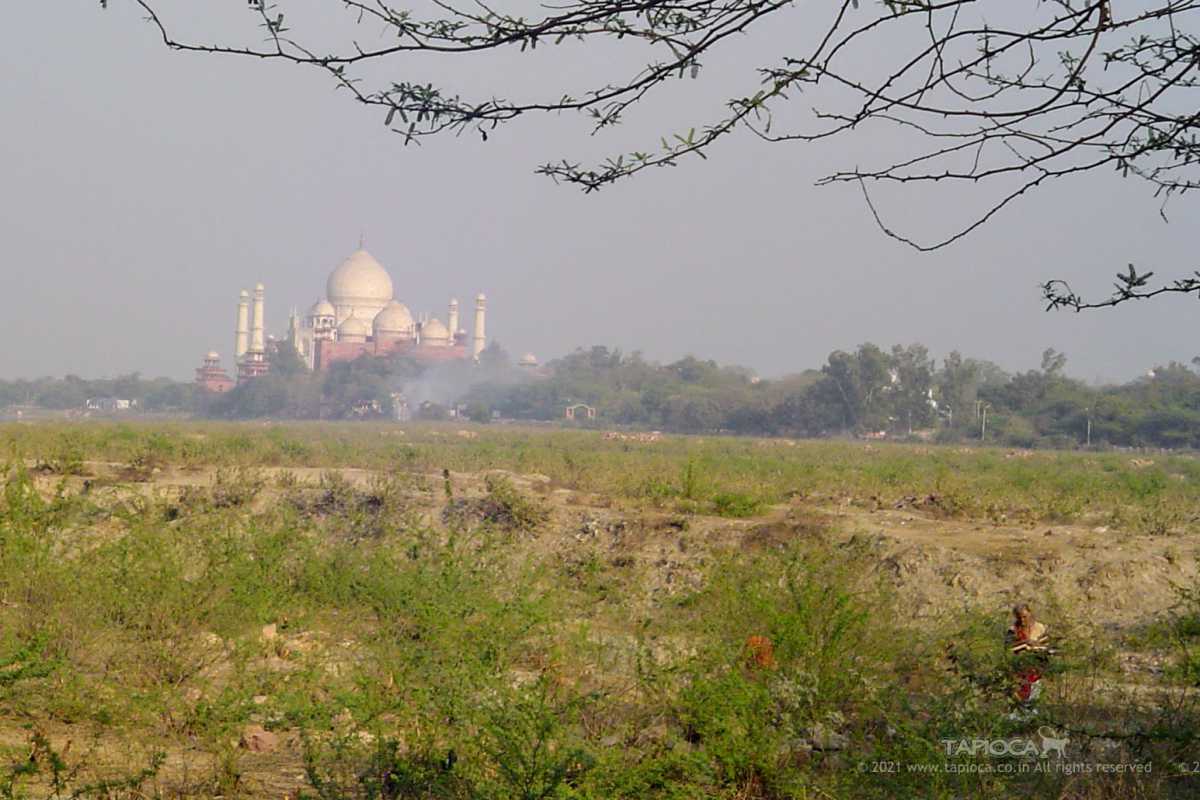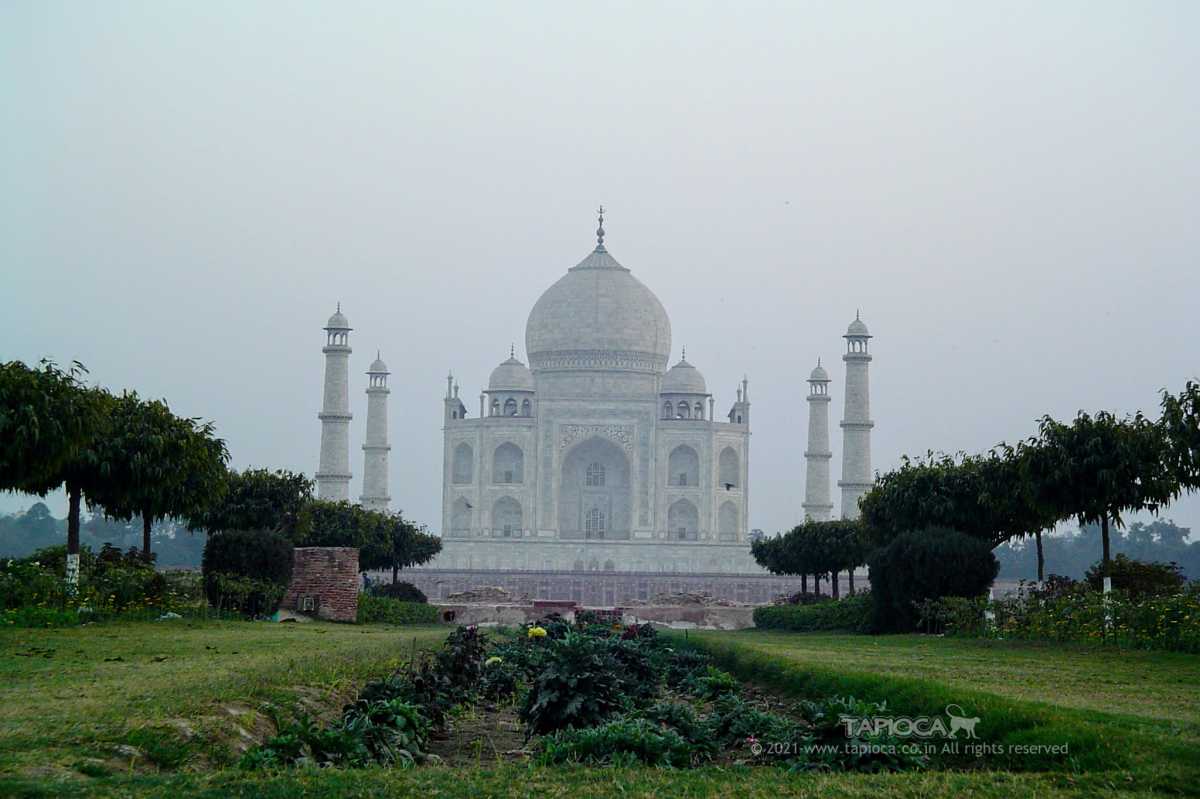Construction of Taj Mahal

seen from Yamuna River bed
The site for Taj Mahal was decided to be along the river Yamuna which was a small bend that would increase the beauty of the building multi-fold. The site belonged to Raja Jai Singh of Amber who was given an equal compensation by Shah Jahan consisting of mansions inside the city of Agra. The site chosen for the construction of Taj Mahal had an added advantage that it was viewable from Shah Jahan’s palace in the Agra Fort. The Construction
S
hah Jahan had a great passion for architecture and the Taj Mahal was one of the best of his many works. The complete construction of the Taj Mahal and the adjoining complexes and gardens included the efforts of many world famous designers and 20,000 laborers put together for a period of 22 years. The construction of the monument started in 1631 and continued till 1653 with thousands of laborers working day and night for its completion.The Site for Taj Mahal
The site for Taj Mahal was decided to be along the river Yamuna which was a small bend that would increase the beauty of the building multi-fold. The site belonged to Raja Jai Singh of Amber who was given an equal compensation by Shah Jahan consisting of mansions inside the city of Agra. The site chosen for the construction of Taj Mahal had an added advantage that it was viewable from Shah Jahan’s palace in the Agra Fort.
Construction
Once the construction started, almost about three acres of land were excavated and filled with dirt for seepage reduction and the ground was levelled at about 50 metres above the riverbank. The initial construction started with the digging of wells as foundation for the tomb. A huge brick scaffold instead of bamboo that mirrored the tomb and legends claim that this scaffold whose removal was predicted to take years was dismantled just overnight. This was done so quick as Shah Jahan passed a decree stating that anyone who removes it could keep the bricks. It is said that a 15 km ramp was built of earth for transporting the construction material and the marble that was needed for the construction of the Taj Mahal. Elephants and Oxen were employed to help pull specially designed wagons loaded with these materials. From the ramp, the materials were raised to desired position by use of post-and-beam pulley mechanism system. The water needed for the construction was also bought in by pulley mechanisms from the river.
Artists and Workers
Many renowned artists were involved in the work of the Taj Mahal throughout its construction. The Taj Mahal has a creative team in place of about 37 men which included sculptors, calligraphers from Persia, inlayers who came from the southern part of India, stonecutters of Baluchistan, a designer specializing in carving marble flowers, an expert of turret building, etc. Many designers and architects submitted their ideas and wooden models to Shah Jahan who decided on the model after careful consideration. The design for the Taj Mahal was finally produced by Ustad Ahmad Lahauri.
Sculptors and calligraphers from Persia and other parts of the world were involved in the work of the Taj Mahal. The calligraphy works on the Taj Mahal was done by Amanat Khan Shirazi whose name is inscribed along the gates of Taj. The verses on the tombstone of the queen was composed by the poet Ghyasuddin and the dome made by the Turkish designer Ismail Khan Afridi. ‘Puru’ of Persia was known to be the supervising architect with thousands of labourers from many arts of India was leashed into the construction work of Taj Mahal.
The gold finial was cast by Qazim Khan of Lahore while Chiranjilal from Delhi was the chief sculptor and mosaic architect.
Architectural Details
The entire piece of Taj Mahal measures 1902 feet x 1002 feet on each side and is a rectangular plot with oblong section on the north and south side. The main attraction is a white marble tomb that stands on a square platform covered by a large white dome. Four symmetrical minarets surround the primary domed tomb at each corner o the square platform. The tomb houses the graves of the Mughal emperor Shah Jahan and his wife Mumtaz Mahal on whose memory, it was built. The forecourt which is guarded by the main gate lies in the southern point of the whole complex which houses the tombs of the other two queens of Shah Jahan namely Akbarabadi Mahal and Khandahari Mahal.
There is a 300 metre square garden that is set within the entire complex and is known as the Charbagh garden. The name implies that the garden is equally divided into four sections by pathways which are further divided by raised pathways creating a beautiful view. The garden also contains a marble water tank which reflects the beautiful view of the Taj Mahal. The complex also contains a red sandstone mosque on the western side which adds a new contrasting look to the whole view of the Taj Mahal.
The Taj Mahal was divided architecturally into five different sections.
The Moonlight Garden
This is the garden in the northern side which faces the river Yamuna.
The riverfront Terrace - The main section of the Taj Mahal which contains the mausoleum, mosque and the jawab.
The Charbaugh Garden – This garden contains the pavilions situated around the Taj Mahal.
The Jilaukhana – It is an accommodation for the attendants of the tomb and to other subsidiary tombs.
The Taj Ganji – Originally a bazaar, only traces remain of this place which is now preserved.
The Tomb
The tomb of Mumtaz Mahal was built with utmost lavishness and artistic planning. The inspiration for the tomb was taken from Humayun’s tomb and Abdul Rahim Khan-i-Khana’s tomb in Delhi for the dome topped structure on a raised platform and Akbar’s tomb for the four-pillar design. The tomb of Itmad-ud-Daula inspired the Taj architecture in its innovative work on white marble decorated with precious stone inlaid along it. The calligraphic work done in Akbar’s tomb so greatly impressed Shah Jahan as a result of which he decided on employing the same designer for the Taj Mahal also.
The tomb of Mumtaz was covered with a rail of gold before the second anniversary of her death in 1633. Peter Mundy states that the work was in fast progress and metals such as gold and silver were used as lavishly as ever seen before. Precious metals were considered normal metals and marble treated as an ordinary stone. The gold railing on her tomb was later replaced by a latticed octagonal screen known as the Mahajar-i-mushababbak. It encloses the two cenotaphs and is an artistic work in gold crafted in a Turkish style. In short the Taj Mahal was constructed in great grandeur with high levels of cost spent on planning and adorning her tomb along with the other structures.
The Town of Taj Ganj
During the construction of the mausoleum, a small town was built exclusively for the labourers who worked on the construction. This town was named as ‘Mumtazabad’ initially after Mumtaz Mahal though was later renamed to Taj Ganj or Taj Ganji.

Taj seen from Mehtab Bagh
Taj seen from Mehtab Bagh. Arjumand Banu Begum or more popularly known as Mumtaz Mahal was Shah Jahan’s third wife and the daughter of Shah Jahan’s step-mother Nur Jahan’s brother, Asaf Khan. She is world-famous not just for her 19 long loving years of married life with Shah Jahan but also for the memorial built for her after her death, the beautiful Taj.
